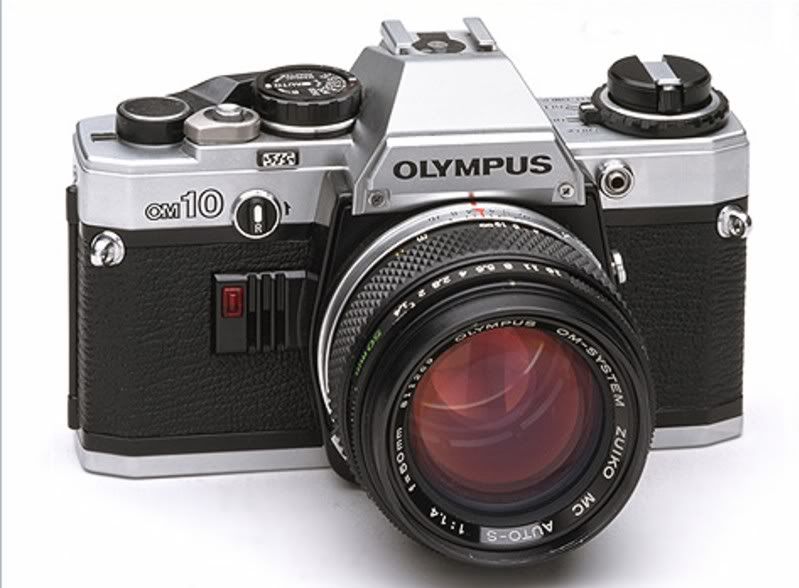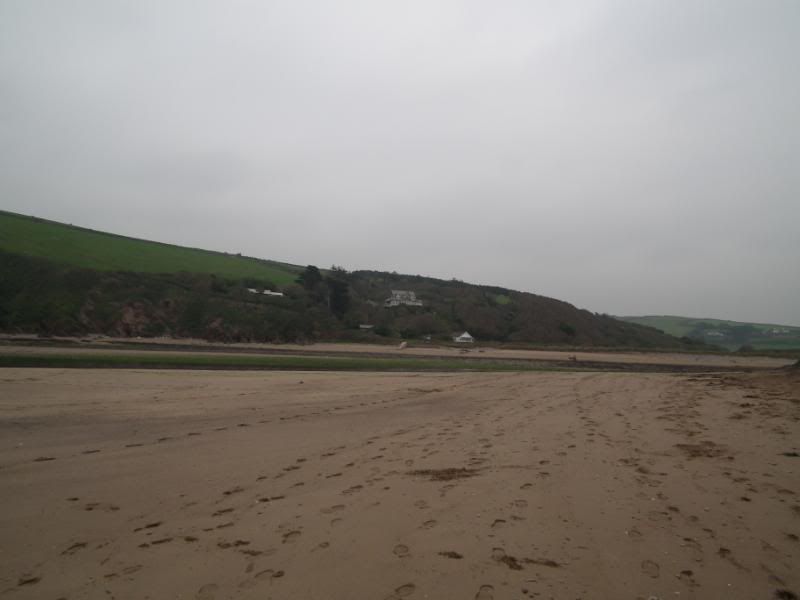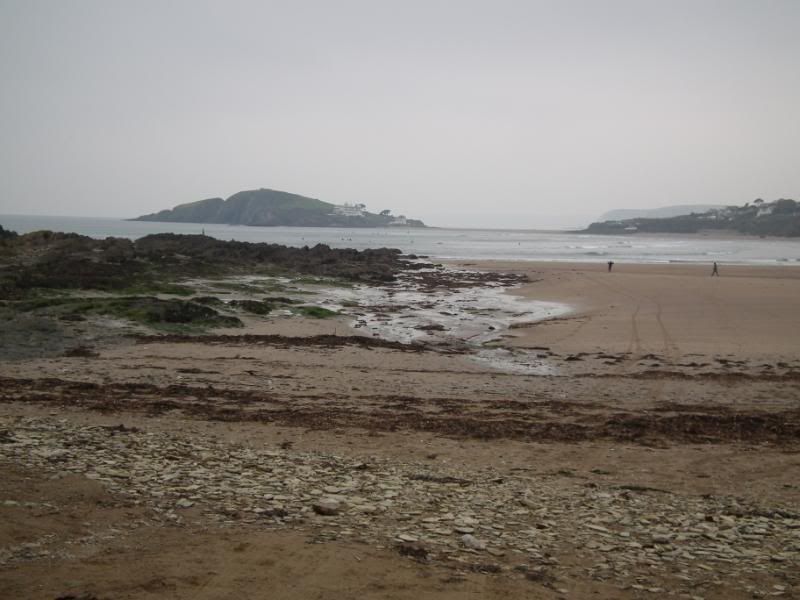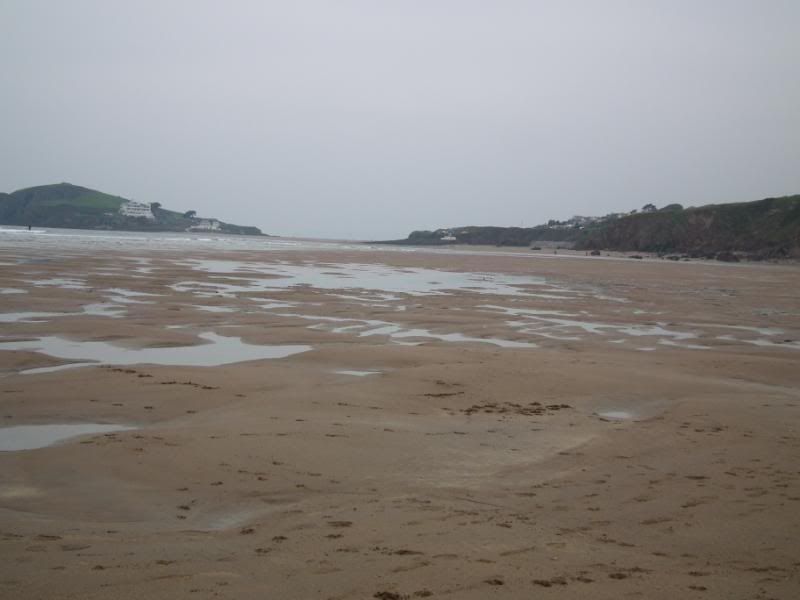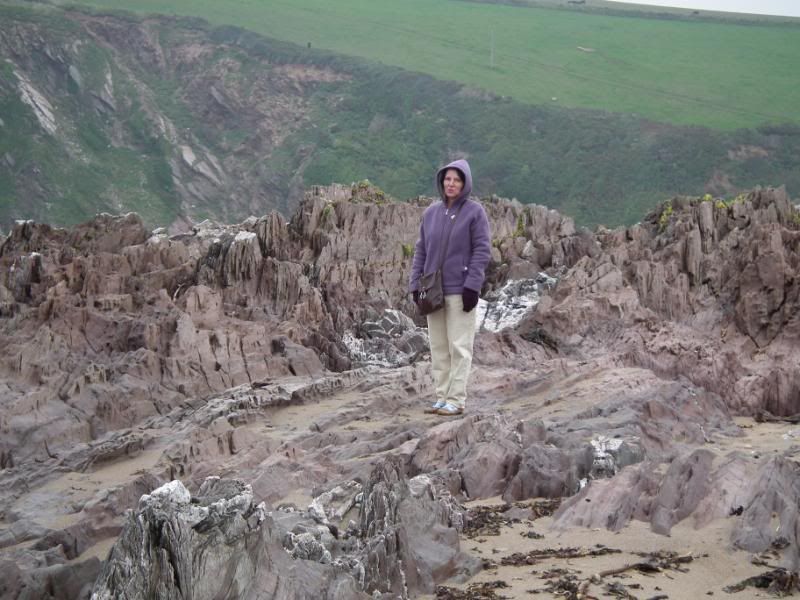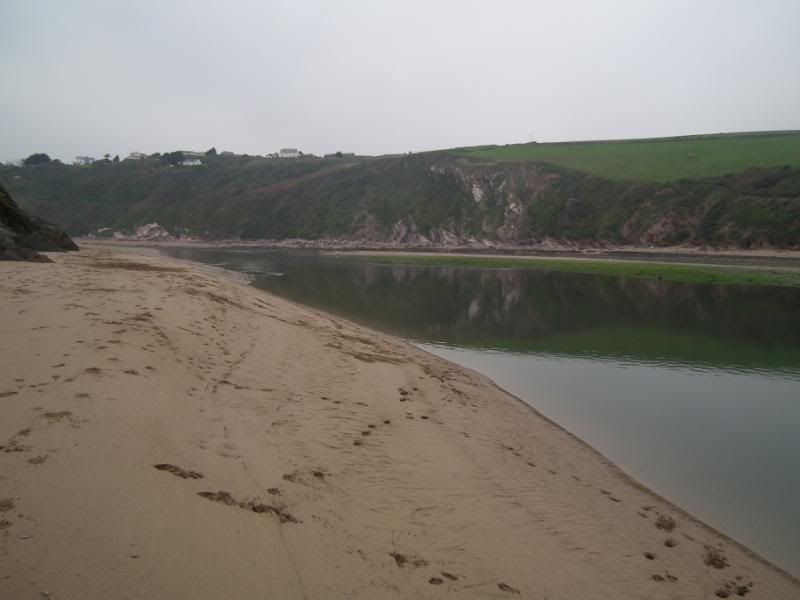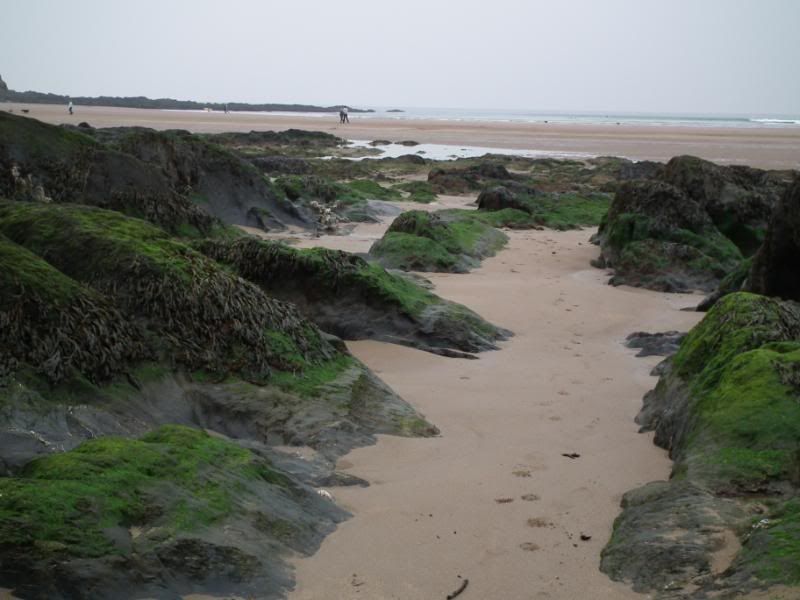Post by Dave on May 31, 2010 14:29:59 GMT
As someone who has had a real love of photography from my early 20’s I’m a bit ashamed to state that I have become a very lazy photographer over the last few years and most of that is down to today’s modern digital camera’s that you always end up leaving in the program mode.
Yes I have become no more that a point and shot photographer for most of the photo’s I have been taking, the only real exception has been when I have been working to improve my action photography at football games where you are allowed to take photos such as games Ant will play in.
The daft thing is having leaned most of the things I needed to learn about photography and serving a long apprenticeship on old film SLR cameras, I wanted to make sure I bought a digital camera that would still give me all the full control over such things as aperture settings and shutter speeds so I could play around with exposures and depth of field etc and after buying such a camera I ended up falling into the trap of just using it in auto program mode.
As a teenager I had one of those Kodak camera’s most people owned and I also later bought a Polaroid camera that I’m sure only took black and white photos but at least with that one you were able to hold the picture you had just taken a few minutes later in your hand and look at it.
At the age of 20 years old I wanted to learn about photography and buy a camera that would give my the opportunity to start taking much better pictures, the only problem was I was earning no more that £25 a week, was married and Ant was on the way.
I loved looking in the camera shop windows but knew most of the cameras were simply unaffordable for me and owning a really top and expensive camera was just a dream.
But I was determined to get into photography and I remember going to a camera shop in Higher Union Street in Torquay (just up past the old bowling alley) and buying the only SLR camera I could afford the Zenit E. This was a Russian built camera that was very heavy and did not have such things as light meters built into it. It was a case of having to set the camera up for every shot and learning and understanding the relationship between the aperture and shutter speed settings to get the correct exposures.
The biggest problem was that as you had to take the roll of film to the chemists to get it developed once you had taken all the shots you could on it, it was never the case you could just take all the pictures you wanted to, so unlike today using digital camera’s.
The Zenit E Camera

I really did enjoy owning and using the Zenit E camera but after a year or so it was time to look and see if I could move onto a better camera and thanks to the Jeff Williams shop in Market Street Torquay I was able too. I did have to trade something in I really wanted to keep, but I fell in love with the thought of owning the Minolta X700 he had in his window and so in the end I did the deal and became the very proud owner of that camera.
I was soon saving up for new lenses for it and a motor winder to bolt onto the bottom of it along with a good flashgun and also filters etc. Now I did not need to worry about such things as exposure as I could select shutter priority for action shots or aperture if I wanted to be creative using such things as depth of field etc.
I still had to manually focus all the shots but that was fine as I still felt I was playing a big part in the final result. One thing I loved about the x700 was if I took off the motor winder I had bought for it and wound the film on using the hand winder, there was a way to slip the clutch so you could take two pictures on the same bit of film.
This was fun as I had a filter that blocked off half the lenses and I would take pictures of Ant sitting on one end of the sofa looking angry say and then turn the filter around, cock the camera to fire again only this time have him sitting up the other end of the sofa laughing.
There was still the problem of never really being able to take as many pictures as one would have liked, but by now you were able to pop that film in an envelope and get them processed so much cheaper as long as you did not mind waiting a week for the pictures to come back.
That was also fun in its own way as there would be some photos you were proud of and others you found yourself asking what happened with that shot. Some you would look at and wonder if what you were now looking at was a picture you had taken in the first place.
The Minolta x700

My best shot I ever took with the x700, taken on the footbridge on Torquay Seafront and it was a four minute exposure covering up the lenses many times during that time.
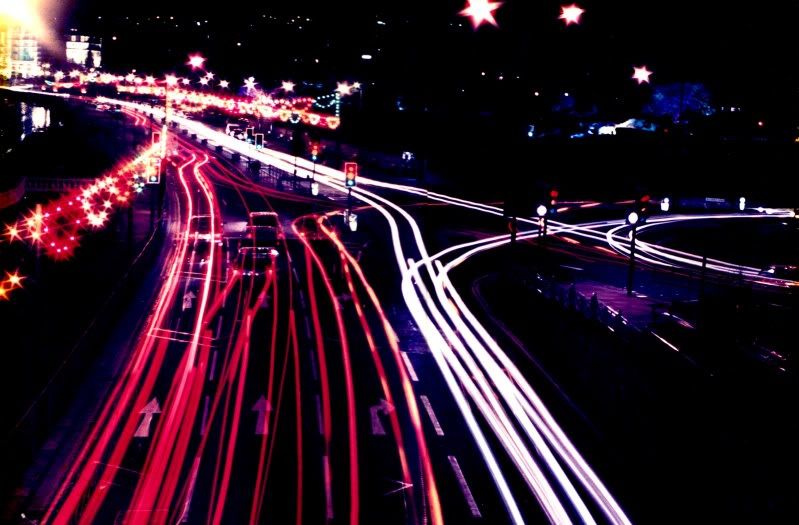
I then moved onto my next camera and one I know Chris Hayes bought last year to play around with the Minolta x7000; this one had a build in film winder and an auto focus lenses system and I believe it was this camera that was responsible for me becoming a rather lazy photographer.
It just got such good results using it in its program mode and slowly but surely I ended up more just pointing and shooting images and mostly happy with the results I was getting. But being able to always take control back into my own hands if I wanted was always an option and as I said something I did not want to give up when I switched to digital photography.
The Minolta x7000
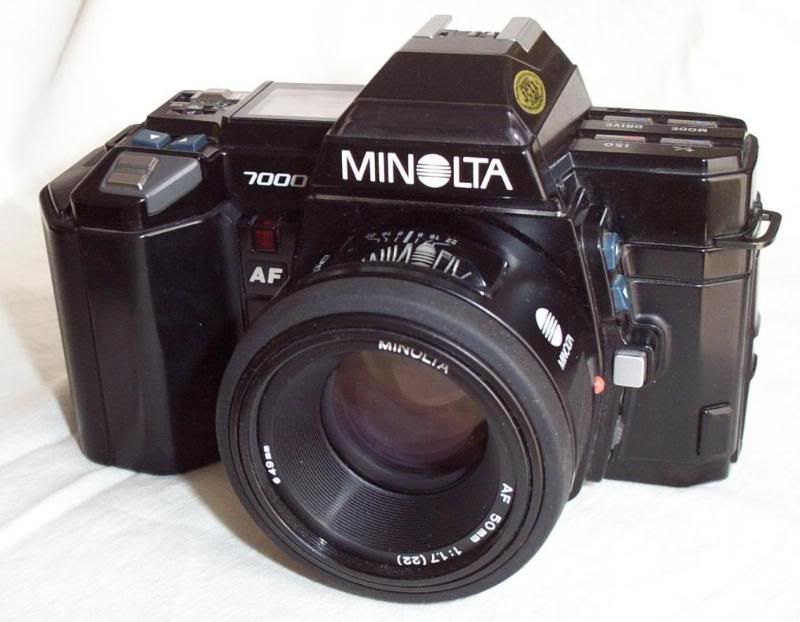
Carol and I went to Argos to buy our very first digital camera, it was cannon and back then the cameras had so few pixels and the quality of the pictures was nothing very special and also the zooms on them were rubbish. No good trying to get closer using the digital zoom as the quality became ever poorer and so I held only my X7000.
That was until the Fuji S5000 came out and here was a camera that was a real bridge between normal digital cameras and a top SLR digital camera and I fell in love with the S5000 so much I was prepared to trade in my X7000 and all the kit such as the long lenses I had bought to use with it as it was the only way I could really afford to buy the S5000.
Now I really could just take all the pictures I wanted to and I fell in love with photography even more, the only restrictions were only going to be the size of memory card you owned and the amount of good rechargeable batteries you also owned. But as we know the cards have really moved on and you can take hundreds of pictures in one day and the very best batteries last the whole day as well.
The Fuji S5000
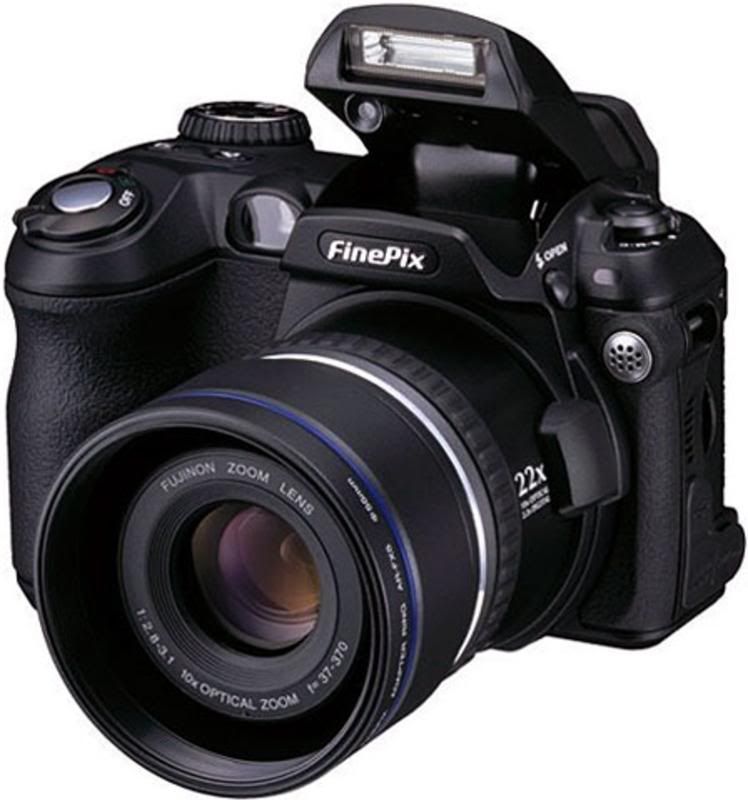
After bringing out a few more new models Fuji then made another camera I felt I just had to own the S95000. So much better than the S5000 and with a much larger focal range and instead of having to press buttons to zoom in, now the camera had a proper lenses you just twisted by hand to zoom making it so much faster and so more accurate to zoom. The first camera of this type to have a 10X optical lenses
Four and a half years later and having taken many thousands of photos with my S95000 it still looks brand new( old school man who looks after everything he owns) and still works perfectly. It was when I looked at the pictures I took of the powerboat racing I wished I had an even longer focal length on the camera as then I could have gotten even closer shots of the boats going over the waves.
So I spent some time yesterday checking out such things as 2X converters and while there were some cheap ones on Ebay after doing a good deal of research I discovered there are all sorts of problems using 2X converters such as not being able to focus the camera and also dark edges around the pictures even from the ones that cost £200.
I then came across the new Fuji camera that has an unbelievable 30X optical zoom lenses built on it and just for a while I found myself checking out the best deals that could be found for this baby. If PC World In Torquay had have had one in stock, I may well have gone over and bought it and feeling a bit frustrated they did not have it in stock, I started reading the handbook that came with my S95000.
Having felt before that digital zoom was just rubbish I never read in the handbook how to use it on my S95000, but now I was reading the page and I learned it was as simple as just touching a button to turn my 10X optical zoom into a 22X digital zoom.
I was soon out in the garden trying this out and not just in the program modes, I was trying it out using the camera the way I intended to use it when I bought it and I was so amazed later when I checked out all the photos on my PC.
The digital zoom shots were brilliant with no real lose of quality and as for all the other shots I took, it was clear to see the real difference getting the camera off the program mode and using it more manually can really make.
So I won’t be buying the new Fuji camera and am so looking forward to start using my camera the way it was intended to be used by someone who has a good understanding of photography.
So my advice is get that camera of the program mode and go and play and have fun and be more creative taking those pictures, you only get to take most of them only the once and why not take the time to make than as best as you can.
Fuji S95000
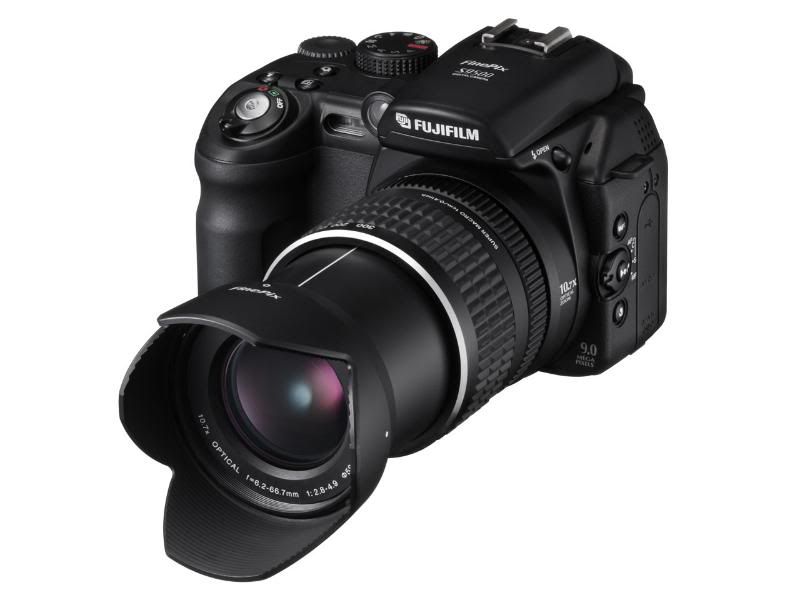
Yes I have become no more that a point and shot photographer for most of the photo’s I have been taking, the only real exception has been when I have been working to improve my action photography at football games where you are allowed to take photos such as games Ant will play in.
The daft thing is having leaned most of the things I needed to learn about photography and serving a long apprenticeship on old film SLR cameras, I wanted to make sure I bought a digital camera that would still give me all the full control over such things as aperture settings and shutter speeds so I could play around with exposures and depth of field etc and after buying such a camera I ended up falling into the trap of just using it in auto program mode.
As a teenager I had one of those Kodak camera’s most people owned and I also later bought a Polaroid camera that I’m sure only took black and white photos but at least with that one you were able to hold the picture you had just taken a few minutes later in your hand and look at it.
At the age of 20 years old I wanted to learn about photography and buy a camera that would give my the opportunity to start taking much better pictures, the only problem was I was earning no more that £25 a week, was married and Ant was on the way.
I loved looking in the camera shop windows but knew most of the cameras were simply unaffordable for me and owning a really top and expensive camera was just a dream.
But I was determined to get into photography and I remember going to a camera shop in Higher Union Street in Torquay (just up past the old bowling alley) and buying the only SLR camera I could afford the Zenit E. This was a Russian built camera that was very heavy and did not have such things as light meters built into it. It was a case of having to set the camera up for every shot and learning and understanding the relationship between the aperture and shutter speed settings to get the correct exposures.
The biggest problem was that as you had to take the roll of film to the chemists to get it developed once you had taken all the shots you could on it, it was never the case you could just take all the pictures you wanted to, so unlike today using digital camera’s.
The Zenit E Camera

I really did enjoy owning and using the Zenit E camera but after a year or so it was time to look and see if I could move onto a better camera and thanks to the Jeff Williams shop in Market Street Torquay I was able too. I did have to trade something in I really wanted to keep, but I fell in love with the thought of owning the Minolta X700 he had in his window and so in the end I did the deal and became the very proud owner of that camera.
I was soon saving up for new lenses for it and a motor winder to bolt onto the bottom of it along with a good flashgun and also filters etc. Now I did not need to worry about such things as exposure as I could select shutter priority for action shots or aperture if I wanted to be creative using such things as depth of field etc.
I still had to manually focus all the shots but that was fine as I still felt I was playing a big part in the final result. One thing I loved about the x700 was if I took off the motor winder I had bought for it and wound the film on using the hand winder, there was a way to slip the clutch so you could take two pictures on the same bit of film.
This was fun as I had a filter that blocked off half the lenses and I would take pictures of Ant sitting on one end of the sofa looking angry say and then turn the filter around, cock the camera to fire again only this time have him sitting up the other end of the sofa laughing.
There was still the problem of never really being able to take as many pictures as one would have liked, but by now you were able to pop that film in an envelope and get them processed so much cheaper as long as you did not mind waiting a week for the pictures to come back.
That was also fun in its own way as there would be some photos you were proud of and others you found yourself asking what happened with that shot. Some you would look at and wonder if what you were now looking at was a picture you had taken in the first place.
The Minolta x700

My best shot I ever took with the x700, taken on the footbridge on Torquay Seafront and it was a four minute exposure covering up the lenses many times during that time.

I then moved onto my next camera and one I know Chris Hayes bought last year to play around with the Minolta x7000; this one had a build in film winder and an auto focus lenses system and I believe it was this camera that was responsible for me becoming a rather lazy photographer.
It just got such good results using it in its program mode and slowly but surely I ended up more just pointing and shooting images and mostly happy with the results I was getting. But being able to always take control back into my own hands if I wanted was always an option and as I said something I did not want to give up when I switched to digital photography.
The Minolta x7000

Carol and I went to Argos to buy our very first digital camera, it was cannon and back then the cameras had so few pixels and the quality of the pictures was nothing very special and also the zooms on them were rubbish. No good trying to get closer using the digital zoom as the quality became ever poorer and so I held only my X7000.
That was until the Fuji S5000 came out and here was a camera that was a real bridge between normal digital cameras and a top SLR digital camera and I fell in love with the S5000 so much I was prepared to trade in my X7000 and all the kit such as the long lenses I had bought to use with it as it was the only way I could really afford to buy the S5000.
Now I really could just take all the pictures I wanted to and I fell in love with photography even more, the only restrictions were only going to be the size of memory card you owned and the amount of good rechargeable batteries you also owned. But as we know the cards have really moved on and you can take hundreds of pictures in one day and the very best batteries last the whole day as well.
The Fuji S5000

After bringing out a few more new models Fuji then made another camera I felt I just had to own the S95000. So much better than the S5000 and with a much larger focal range and instead of having to press buttons to zoom in, now the camera had a proper lenses you just twisted by hand to zoom making it so much faster and so more accurate to zoom. The first camera of this type to have a 10X optical lenses
Four and a half years later and having taken many thousands of photos with my S95000 it still looks brand new( old school man who looks after everything he owns) and still works perfectly. It was when I looked at the pictures I took of the powerboat racing I wished I had an even longer focal length on the camera as then I could have gotten even closer shots of the boats going over the waves.
So I spent some time yesterday checking out such things as 2X converters and while there were some cheap ones on Ebay after doing a good deal of research I discovered there are all sorts of problems using 2X converters such as not being able to focus the camera and also dark edges around the pictures even from the ones that cost £200.
I then came across the new Fuji camera that has an unbelievable 30X optical zoom lenses built on it and just for a while I found myself checking out the best deals that could be found for this baby. If PC World In Torquay had have had one in stock, I may well have gone over and bought it and feeling a bit frustrated they did not have it in stock, I started reading the handbook that came with my S95000.
Having felt before that digital zoom was just rubbish I never read in the handbook how to use it on my S95000, but now I was reading the page and I learned it was as simple as just touching a button to turn my 10X optical zoom into a 22X digital zoom.
I was soon out in the garden trying this out and not just in the program modes, I was trying it out using the camera the way I intended to use it when I bought it and I was so amazed later when I checked out all the photos on my PC.
The digital zoom shots were brilliant with no real lose of quality and as for all the other shots I took, it was clear to see the real difference getting the camera off the program mode and using it more manually can really make.
So I won’t be buying the new Fuji camera and am so looking forward to start using my camera the way it was intended to be used by someone who has a good understanding of photography.
So my advice is get that camera of the program mode and go and play and have fun and be more creative taking those pictures, you only get to take most of them only the once and why not take the time to make than as best as you can.
Fuji S95000


